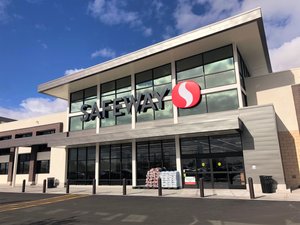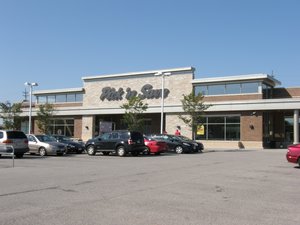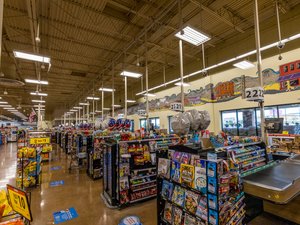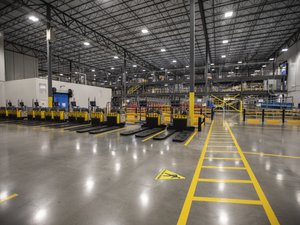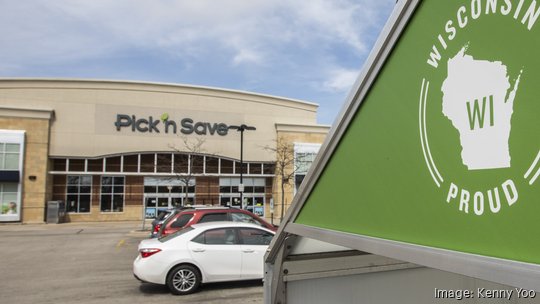
Kroger Co. is using artificial intelligence in a variety of ways to improve its performance while expanding profit margins through gains in its store brand sales.
Those were some of the key items revealed when Kroger CEO Rodney McMullen spoke to investors and analysts on a conference call June 15 to discuss first-quarter earnings.
Cincinnati-based Kroger (NYSE: KR), the nation’s largest operator of traditional supermarkets including Pick 'n Save and Metro Market stores in the Milwaukee area, has made significant inroads in using artificial intelligence in a variety of areas, McMullen said. That starts with improving its already-strong ability to give customers the best type of promotions for products that are relevant to them.
“As AI advances, we continue to work and constantly evaluate potential use cases throughout the business, with privacy and responsible implementation in mind,” McMullen said.
Kroger can use AI to provide a simpler digital experience for customers along with better personalized product recommendations, McMullen said. It can also provide better alternatives when a customer has ordered a product that is temporarily unavailable.
“Our teams are working with search algorithms and generative AI to improve substitution accuracy and search results,” McMullen said.
Kroger also is using AI to more efficiently determine findings from large swaths of customer data, McMullen said.
“By applying AI to customer surveys and customer service logs, our team can analyze and categorize them in minutes versus days before,” he said. “This allows the business to react to customer feedback more quickly and accurately, and then reflect these learnings in the customer experience.”
He also believes Kroger can reduce the number of items that are out of stock, improve inventory management and cut expenses through the use of AI and advanced algorithms.
“Data is in our DNA,” McMullen said. “Our rich history as a technology leader gives us confidence that we will continue to effectively use AI.”
Meanwhile, Kroger’s gross margin was 22.3% last quarter, which ended in May. That was up 0.21 percentage points from the year-ago quarter.
Sales of Kroger’s store brands, which it calls Our Brands, played a big part in that margin improvement. Our Brands sales rose 4.9% during the quarter. That’s faster growth than its overall same-store sales improvement of 3.5%.
That’s a huge deal because Kroger generates 6 to 8 percentage points wider margins on its Our Brands sales than it does when it sells national brands, McMullen said.
“Our Brands delivered another solid quarter led by our namesake Kroger brand, a national brand equivalent,” McMullen said. “In this period of sustained high inflation, it helps our customers save money without sacrificing quality. While inflation may have been the reason for some customers trying our Our Brands products, the taste and quality makes the customer love these products and continue to repurchase them.”
Home Chef, Kroger’s prepared meal brand, expanded its menu last quarter to add more healthy options and a wider variety of meals. Kroger launched Smart Way as a value-priced store brand a year ago. It plans to promote that brand and its lower-priced products more, McMullen said. While Kroger has added loyal households and market share, high inflation and changes in government assistance have hindered its sales with lower-income shoppers.
McMullen and CFO Gary Millerchip also discussed:
Alternative profits
Kroger generates a growing chunk of profits from alternative businesses outside of its grocery sales. It continues to innovate and add ways to expand that business.
Kroger recent launched cooler screens in stores to enhance advertising sales.
“These innovative screens will replace traditional refrigerator and freezer doors with a digital overlay that will offer customers information on products as well as Kroger Precision Marketing-curated advertisements,” Millerchip said. “This will bring a differentiated shopping experience to our customers while also creating another powerful marketing tool for KPM to offer to our brand partners.”
Kroger also recently teamed with Disney to provide audience targeting and measurement expertise to the entertainment company’s connected TV products streamed to viewers through use of a smart TV, Roku or other formats that connect TVs to streaming services, Millerchip said.
Digital sales
Delivery sales grew 30% in the quarter while digital sales overall increased 15%. Kroger generates more than $10 billion in annual sales through digital means. Most of the delivery growth came from Kroger’s automated Ocado warehouse and distribution facilities, or sheds, as the company calls them. Kroger's Ocado sheds include one in the Kenosha County village of Pleasant Prairie that opened in 2022.
“We're making good progress, especially in Monroe, on ramping that facility up and now we're in the process of rolling those learnings out to the other sheds,” McMullen said.
Albertsons acquisition
McMullen gave an update of Kroger’s planned $24.6 billion acquisition of Boise, Idaho-based rival Albertsons Cos. Kroger will have to sell a to-be-determined number of stores in order to get antitrust approval from regulators.
“We are working … to identify potential buyers for the stores we expect to divest to obtain clearance for the transaction,” McMullen said. “We will find well-capitalized buyers with experienced management teams that will maintain competitiveness. We are very pleased with the level of interest received thus far.”
Kroger and Albertsons are still on track to complete the transaction in early 2024, McMullen said.
